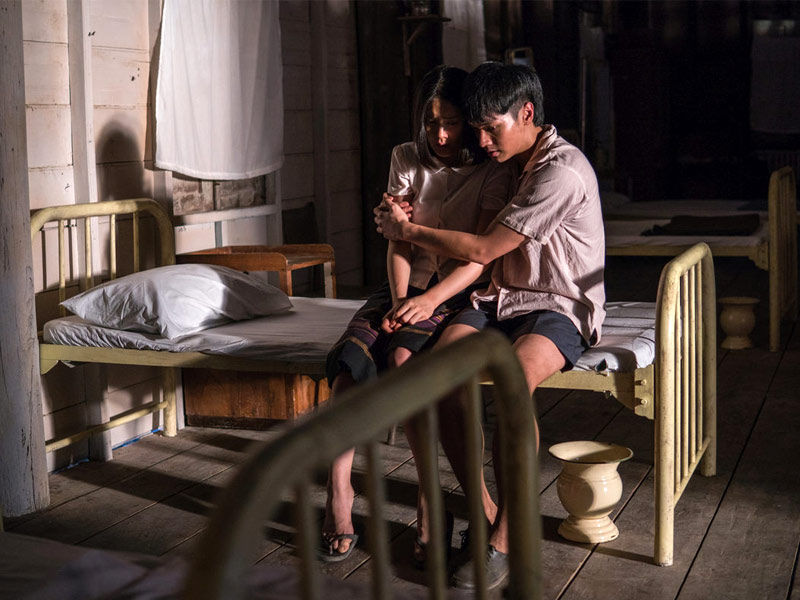While the narrative has been present for generations, most Westerners were first acquainted with it in the popular cult Indonesian film Mystics in Bali, where it was tied with the country’s penanggalan legend.
Because the legends are still very much a part of Thai culture and mythology, a tiny resurgence of films starring the monster has begun to find its way out to the rest of the globe, including Sitisiri Mongkolsiri’s newest attempt, which will be shown at the Five Flavours Asian Film Festival.

When Noi (Oabnithi Wiwattanawarang) arrives in a secluded hamlet, he immediately discovers that the inhabitants are still treating local girl Sai (Phantira Pipiyakorn) as the community pariah. Despite her childhood friend Jerd’s (Sapol Assawamunkong) best efforts to calm the people’s anger for the creature, a string of fatalities in the neighborhood further fuels their desire to hunt down the Krasue who is chasing everyone in the town.
When he unintentionally finds that she is the thing they’ve been pursuing all along, his initial willingness to care for her enables the tribe to rest as the reduced dead count eases their anxieties. However, with no one to hold accountable, the villagers become agitated and demand that one be brought forth, placing the three of their friends in jeopardy.

There was a lot to enjoy about “Krasue.” Part of the film’s strengths stems from screenwriter Chookiat Sakveerakul’s decision to focus on an underappreciated portion of the Krasue/Penanggalan mythology.
This takes its basic idea by including the creature’s cursed lineage origin narrative rather than the black magic approach. The fact that so few people are aware that the actual nature of the Krasue can be shared in this fashion adds to the storyline’s freshness and uniqueness, especially given the build-up to the revelation regarding Sai’s true origin.

This is portrayed through vivid nightmares and flashbacks that depict the misery of being such a dreadful monster yet unable to stop it as she gradually becomes aware of her condition.
That all adds to the significance of the subsequent love triangle between Sai, Noi, and Jerd, as the soothing nature they give in rekindling the relationship helps to calm her mind and forget the predicament once the fact is ultimately disclosed. The love component that emerges from that plot structure is sincere and passionate, bringing much depth to the tragedy that follows.

Furthermore, the tense stalking in the local woodland works quite well in the film. The ambiance is amazing and terrifying, from the first game of hide-and-seek to the Krasue hunts that the villagers participate in that are lighted by candles. When combined with the accumulating animal deaths, these early sights offer the early justification for the fear that drives the villagers’ increasingly urgent quest to identify the entity responsibly.
The assault sequences themselves are very scary and terrifying, with the head being separated from the body and the floating head soaring across the hamlet and surrounding jungle with the red eyes shining brightly against the gloomy backdrop. In addition, the interaction with the villagers hunting for the creature in the small girl highlights the wonderful combination of physical and CGI effects made by Sirirat Jamfah for the beast and adds to what we enjoy about “Krasue.”

The fundamental relationship between Sai and Noi will likely be the most decisive aspect of the picture. The idea of being able to love such a hideous, bloodsucking creature capable of inflicting violence and terror on the villagers comes across quite strongly, with Noi shown feeding it dead birds and animals to keep her from attacking others or standing by each other’s side despite the other villagers’ threats to kill her.
Also read: The Mysterious story of the Terracotta Army
Taking into consideration the ending, with the decision to face up to the monster thing before him while still being a plain human, and then running away together to save each other from the people, adds to the love side plot that runs throughout the film.
Even the race to heal her using local remedies adds to the emotional effect of Sai and Noi’s relationship, bringing up a topic that may not be appreciated by those who prefer a horror-based tale.
The sappy nature of these moments may turn off viewers and be viewed as the reason for the film’s length. This is especially true of the continual slow motion that drags these out to emphasize the weight behind the action. However, that is the only significant problem in the picture.

“Krause” has something to appeal to almost everyone, thanks to some very amazing and heartfelt elements. This is not only highly recommended for fans of the Asian horror genre, but also for those searching for a new monster feature and general cinema lovers who aren’t into this sort of picture, while viewers who aren’t convinced by the film’s aspects should exercise care. available on Netflix exclusively.





























